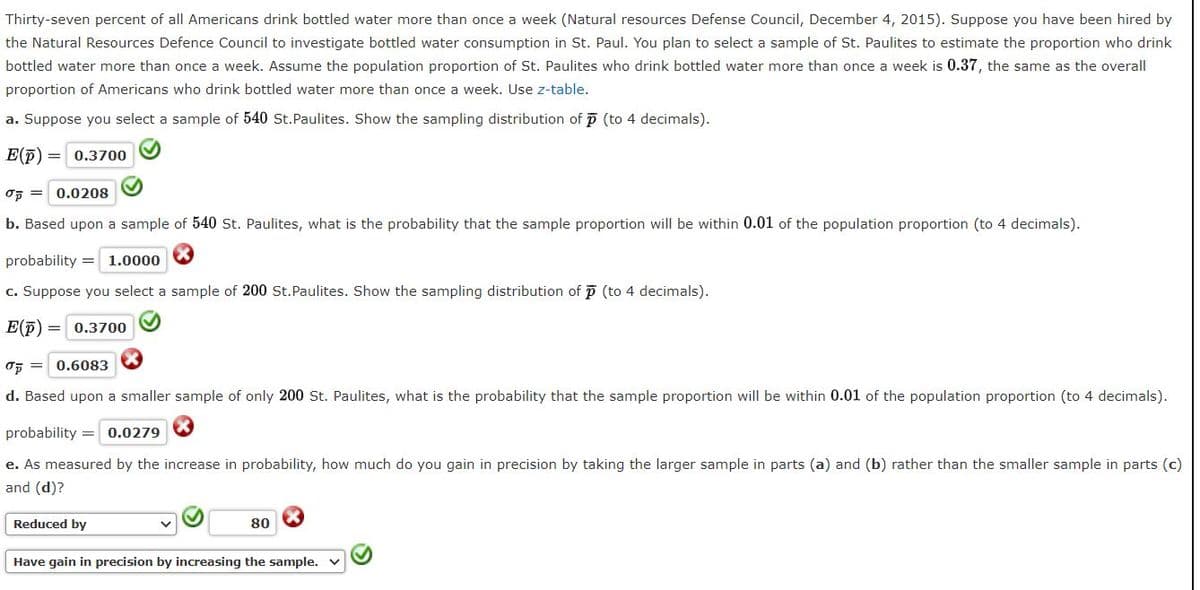Thirty-seven percent of all Americans drink bottled water more than once a week (Natural resources Defense Council, December 4, 2015). Suppose you have been hired by he Natural Resources Defence Council to investigate bottled water consumption in St. Paul. You plan to select a sample of St. Paulites to estimate the proportion who drink ottled water more than once a week. Assume the population proportion of St. Paulites who drink bottled water more than once a week is 0.37, the same as the overall proportion of Americans who drink bottled water more than once a week. Use z-table. a. Suppose you select a sample of 540 St.Paulites. Show the sampling distribution of p (to 4 decimals). E(p) = 0.3700 F = 0.0208 p. Based upon a sample of 540 st. Paulites, what is the probability that the sample proportion will be within 0.01 of the population proportion (to 4 decimals). probability = 1.0000 . Suppose you select a sample of 200 St.Paulites. Show the sampling distribution of p (to 4 decimals). E(p) = 0.3700 F = 0.6083 d. Based upon a smaller sample of only 200 St. Paulites, what is the probability that the sample proportion will be within 0.01 of the population proportion (to 4 decimals). probability = 0.0279
Thirty-seven percent of all Americans drink bottled water more than once a week (Natural resources Defense Council, December 4, 2015). Suppose you have been hired by he Natural Resources Defence Council to investigate bottled water consumption in St. Paul. You plan to select a sample of St. Paulites to estimate the proportion who drink ottled water more than once a week. Assume the population proportion of St. Paulites who drink bottled water more than once a week is 0.37, the same as the overall proportion of Americans who drink bottled water more than once a week. Use z-table. a. Suppose you select a sample of 540 St.Paulites. Show the sampling distribution of p (to 4 decimals). E(p) = 0.3700 F = 0.0208 p. Based upon a sample of 540 st. Paulites, what is the probability that the sample proportion will be within 0.01 of the population proportion (to 4 decimals). probability = 1.0000 . Suppose you select a sample of 200 St.Paulites. Show the sampling distribution of p (to 4 decimals). E(p) = 0.3700 F = 0.6083 d. Based upon a smaller sample of only 200 St. Paulites, what is the probability that the sample proportion will be within 0.01 of the population proportion (to 4 decimals). probability = 0.0279
Glencoe Algebra 1, Student Edition, 9780079039897, 0079039898, 2018
18th Edition
ISBN:9780079039897
Author:Carter
Publisher:Carter
Chapter10: Statistics
Section10.6: Summarizing Categorical Data
Problem 10CYU
Related questions
Question

Transcribed Image Text:Thirty-seven percent of all Americans drink bottled water more than once a week (Natural resources Defense Council, December 4, 2015). Suppose you have been hired by
the Natural Resources Defence Council to investigate bottled water consumption in St. Paul. You plan to select a sample of St. Paulites to estimate the proportion who drink
bottled water more than once a week. Assume the population proportion of St. Paulites who drink bottled water more than once a week is 0.37, the same as the overall
proportion of Americans who drink bottled water more than once a week. Use z-table.
a. Suppose you select a sample of 540 St.Paulites. Show the sampling distribution of p (to 4 decimals).
E(p)
0.3700
OF = 0.0208
b. Based upon a sample of 540 St. Paulites, what is the probability that the sample proportion will be within 0.01 of the population proportion (to 4 decimals).
probability =
1.0000
c. Suppose you select a sample of 200 St.Paulites. Show the sampling distribution of p (to 4 decimals).
E(p)
0.3700
OF = 0.6083
d. Based upon a smaller sample of only 200 St. Paulites, what is the probability that the sample proportion will be within 0.01 of the population proportion (to 4 decimals).
probability = 0.0279
e. As measured by the increase in probability, how much do you gain in precision by taking the larger sample in parts (a) and (b) rather than the smaller sample in parts (c)
and (d)?
Reduced by
80
Have gain in precision by increasing the sample. v
Expert Solution
This question has been solved!
Explore an expertly crafted, step-by-step solution for a thorough understanding of key concepts.
This is a popular solution!
Trending now
This is a popular solution!
Step by step
Solved in 2 steps with 2 images

Knowledge Booster
Learn more about
Need a deep-dive on the concept behind this application? Look no further. Learn more about this topic, statistics and related others by exploring similar questions and additional content below.Recommended textbooks for you

Glencoe Algebra 1, Student Edition, 9780079039897…
Algebra
ISBN:
9780079039897
Author:
Carter
Publisher:
McGraw Hill

Holt Mcdougal Larson Pre-algebra: Student Edition…
Algebra
ISBN:
9780547587776
Author:
HOLT MCDOUGAL
Publisher:
HOLT MCDOUGAL

College Algebra (MindTap Course List)
Algebra
ISBN:
9781305652231
Author:
R. David Gustafson, Jeff Hughes
Publisher:
Cengage Learning

Glencoe Algebra 1, Student Edition, 9780079039897…
Algebra
ISBN:
9780079039897
Author:
Carter
Publisher:
McGraw Hill

Holt Mcdougal Larson Pre-algebra: Student Edition…
Algebra
ISBN:
9780547587776
Author:
HOLT MCDOUGAL
Publisher:
HOLT MCDOUGAL

College Algebra (MindTap Course List)
Algebra
ISBN:
9781305652231
Author:
R. David Gustafson, Jeff Hughes
Publisher:
Cengage Learning
